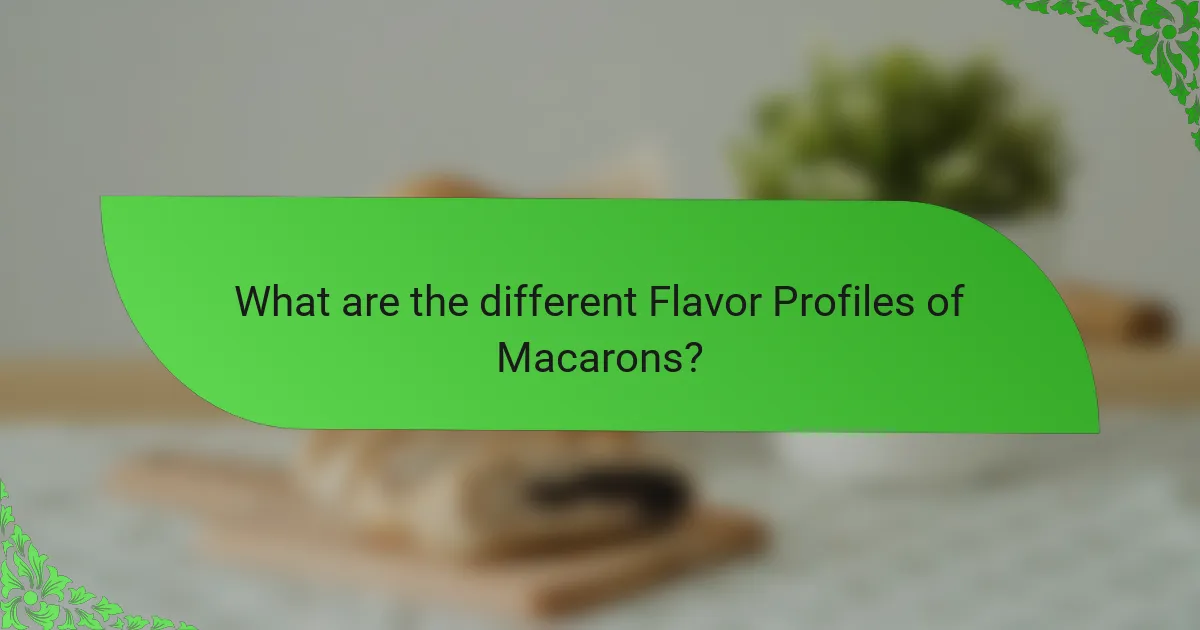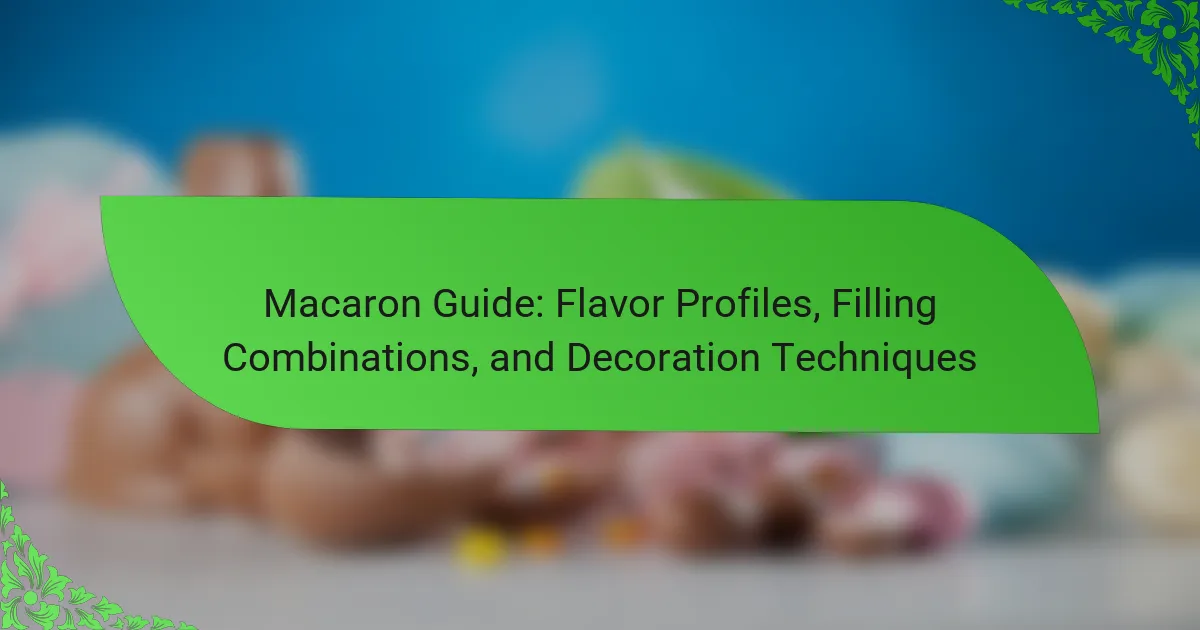Macarons are delicate French confections made from almond flour, egg whites, and sugar, characterized by their smooth shell and soft interior. This guide covers various aspects of macarons, including diverse flavor profiles such as vanilla, chocolate, and seasonal options, as well as popular filling combinations like chocolate ganache and raspberry buttercream. Additionally, it explores decoration techniques that enhance their visual appeal, including airbrushing and edible glitter. The article provides a comprehensive overview of the history, making techniques, and creative possibilities that make macarons a beloved treat.

What are Macarons?
Macarons are delicate French confections made from almond flour, egg whites, and sugar. They feature a smooth, crisp shell with a soft interior. Macarons are typically filled with ganache, buttercream, or jam. Each macaron is often vibrant in color and comes in various flavors. Historical records suggest that macarons date back to the 16th century in Italy. They gained popularity in France in the 19th century. The precise technique for making macarons involves careful temperature control and timing. This contributes to their unique texture and appearance.
How are Macarons different from other cookies?
Macarons are distinct from other cookies due to their unique texture and ingredients. They consist of a delicate meringue made from egg whites and almond flour. This gives them a light, airy structure. Other cookies typically use wheat flour and have a denser, chewier consistency. Macarons are also filled with ganache, buttercream, or jam, adding layers of flavor. Most cookies do not have such elaborate fillings. The preparation of macarons requires precise techniques, such as folding and aging the batter. This differs from the more straightforward methods used for baking typical cookies. The combination of these factors makes macarons a unique pastry experience.
What are the key ingredients in Macarons?
The key ingredients in macarons are almond flour, egg whites, and powdered sugar. Almond flour provides the base and distinct flavor. Egg whites are crucial for creating the meringue structure. Powdered sugar adds sweetness and helps achieve the desired texture. Additionally, granulated sugar is often used to stabilize the meringue. Food coloring is frequently added for aesthetic appeal. Fillings such as ganache, buttercream, or fruit preserves complement the macarons. These ingredients collectively contribute to the unique texture and flavor of macarons.
Why is the texture of Macarons unique?
The texture of macarons is unique due to their delicate, crisp exterior and soft, chewy interior. This contrast is achieved through specific ingredients and techniques. Macarons are made with almond flour, egg whites, and powdered sugar. The meringue used in the batter provides the lightness and airiness. Proper folding techniques create the smooth, shiny surface. The drying process before baking forms a skin that enhances the crunch. Baking at the right temperature ensures the inside remains moist and chewy. This combination of characteristics results in the signature texture that distinguishes macarons from other confections.
What are the origins of Macarons?
Macarons originated in Italy during the 16th century. They were brought to France by Catherine de Medici, who married Henry II. Initially, these cookies were made with almond flour and sugar. The French version evolved over time, incorporating a meringue base. This led to the delicate texture and colorful appearance we associate with macarons today. By the 19th century, they became popular in Parisian patisseries. The addition of fillings, such as ganache and buttercream, further refined the treat. Today, macarons are celebrated worldwide for their unique flavors and artistic presentation.
Where did Macarons first become popular?
Macarons first became popular in France. The refined version of macarons as we know them today originated in French patisseries. They gained prominence in the 20th century, particularly in Paris. The combination of almond flour, egg whites, and sugar created a delicate texture. French chefs began experimenting with flavors and fillings, enhancing their appeal. Notably, Pierre Hermé and Ladurée brought macarons to international fame. Their creative flavor profiles contributed to the dessert’s popularity. Today, macarons are a celebrated treat worldwide, but their roots are firmly in France.
How has the Macaron evolved over time?
The macaron has evolved from a simple almond meringue cookie to a sophisticated dessert. Initially, it originated in Italy in the 8th century and was brought to France in the 16th century. The French version became popular in the 19th century, particularly in Paris. Traditionally, macarons were made with just almond flour, egg whites, and sugar. Over time, pastry chefs began to experiment with various flavors and fillings. Today, macarons come in a wide range of flavors, from classic vanilla to innovative combinations like matcha or lavender. The decoration techniques have also advanced, with colorful designs and artistic presentations becoming common. This evolution reflects broader trends in culinary artistry and consumer preferences for unique desserts.
What are the essential components of a Macaron?
The essential components of a macaron are almond flour, egg whites, and powdered sugar. Almond flour provides the base structure and flavor. Egg whites create the meringue that gives macarons their signature texture. Powdered sugar sweetens the mixture and helps stabilize the meringue. Additionally, food coloring is often used for aesthetic appeal. Fillings such as ganache, buttercream, or jam are crucial for flavor and moisture. These components combine to create the unique texture and taste of a macaron.
What is the significance of the shell in a Macaron?
The shell of a macaron is crucial for its structure and texture. It provides the outer layer that encases the filling. The shell is made from almond flour, egg whites, and sugar. This combination creates a delicate, crisp exterior. The texture contrasts with the soft, chewy interior. The visual appeal of the shell is also significant. It can be colored and decorated to enhance presentation. The shell’s quality affects the overall macaron experience. A well-made shell indicates skill in preparation and technique.
How do fillings enhance the Macaron experience?
Fillings enhance the Macaron experience by providing diverse flavors and textures. They create a balance between the sweetness of the shell and the richness of the filling. Popular fillings include ganache, buttercream, and fruit preserves. Each filling contributes unique taste profiles that can range from fruity to nutty. This variety allows for creative combinations, appealing to different palates. Additionally, fillings can affect the overall mouthfeel, making the macarons more enjoyable. For instance, a creamy ganache adds a smooth texture, while a fruit preserve offers a tangy contrast. This complexity elevates the tasting experience, making macarons a gourmet treat.

What are the different Flavor Profiles of Macarons?
Macarons have diverse flavor profiles that cater to various tastes. Common flavors include vanilla, chocolate, and raspberry. Unique profiles also feature salted caramel, pistachio, and lavender. Seasonal flavors like pumpkin spice or matcha are popular. Fruit-based options such as lemon and passion fruit offer refreshing choices. Additionally, gourmet variations may include rose, coffee, or almond. These flavors are achieved using specific ingredients in the filling and shell. The combination of these elements creates a wide range of taste experiences in macarons.
What are the classic Macaron flavors?
Classic macaron flavors include vanilla, chocolate, raspberry, pistachio, and coffee. Vanilla offers a sweet and creamy taste. Chocolate provides a rich and indulgent flavor. Raspberry brings a fruity and tart profile. Pistachio adds a nutty and earthy essence. Coffee delivers a bold and aromatic experience. These flavors are commonly found in traditional French patisseries. Each flavor enhances the delicate texture of macarons.
How do almond and vanilla influence traditional flavors?
Almond and vanilla significantly enhance traditional flavors in confections like macarons. Almond provides a nutty, slightly sweet taste that complements various fillings. It adds depth and richness, making flavors more complex. Vanilla, on the other hand, imparts a warm, sweet aroma that balances and elevates other ingredients. Together, they create a harmonious blend that is classic in desserts. Historical recipes often feature these ingredients, showcasing their enduring popularity. Their combination is essential in French patisserie, particularly in macarons, where they serve as foundational flavors.
What are popular fruit-based flavor options?
Popular fruit-based flavor options include lemon, raspberry, and passion fruit. Lemon provides a tart and refreshing taste. Raspberry offers a sweet and slightly tangy profile. Passion fruit is known for its tropical and aromatic flavor. Other popular options are strawberry, mango, and blueberry. Each fruit flavor brings its unique sweetness and acidity. These flavors are commonly used in macarons and desserts. They enhance the overall taste experience with vibrant and natural profiles.
How can you experiment with unique flavors?
To experiment with unique flavors, start by combining traditional ingredients with unexpected elements. For example, mix classic vanilla with savory herbs like basil or rosemary. Use spices such as cardamom or saffron to add depth. Incorporate fruits that are less common, like yuzu or dragon fruit, for a refreshing twist. Consider using infused syrups or extracts, such as lavender or earl grey tea, to enhance the flavor profile. Additionally, explore texture by adding crunchy elements like nuts or seeds. This approach allows for creative combinations that can lead to distinctive taste experiences. Experimentation can yield surprising and delightful results in flavor profiles.
What are some unconventional flavor combinations?
Unconventional flavor combinations for macarons include lavender and honey, beetroot and chocolate, and basil and strawberry. Lavender and honey create a floral and sweet profile. Beetroot and chocolate offer an earthy and rich taste. Basil and strawberry combine herbal freshness with fruity sweetness. These combinations challenge traditional flavors and enhance the macaron experience. They reflect culinary creativity and innovation in dessert-making.
How do seasonal ingredients affect flavor choices?
Seasonal ingredients significantly influence flavor choices in culinary creations. They provide freshness and enhance the taste profile of dishes. For instance, summer fruits like berries add sweetness and brightness. In contrast, root vegetables in winter offer earthiness and warmth. Seasonal ingredients often dictate the availability of flavors, leading to a more vibrant and relevant menu. Using these ingredients aligns dishes with the time of year, creating a sense of place and occasion. Studies show that seasonal eating can lead to higher nutritional value due to peak ripeness. This practice not only reflects sustainability but also caters to consumer preferences for freshness.

What Filling Combinations work best for Macarons?
Popular filling combinations for macarons include chocolate ganache, raspberry buttercream, and salted caramel. Chocolate ganache offers a rich, creamy texture that pairs well with various macaron shells. Raspberry buttercream provides a fruity, tart contrast, enhancing the overall flavor profile. Salted caramel adds a sweet and salty dynamic, appealing to diverse taste preferences. Other successful combinations are lemon curd with vanilla, pistachio with rose, and coffee with hazelnut. These pairings balance sweetness and acidity, creating a harmonious taste experience.
What types of fillings can be used in Macarons?
Macarons can be filled with various types of fillings. Common fillings include buttercream, ganache, and fruit preserves. Buttercream can be flavored with vanilla, chocolate, or fruit extracts. Ganache is made from chocolate and cream, providing a rich texture. Fruit preserves offer a tart contrast, enhancing the overall flavor. Additionally, macarons can be filled with cream cheese, curds, or even ice cream. These diverse fillings create a wide range of flavor profiles. Each filling complements the delicate shell of the macaron, making them a versatile treat.
How do ganache fillings differ from buttercream fillings?
Ganache fillings differ from buttercream fillings primarily in their ingredients and texture. Ganache is made from chocolate and cream, resulting in a rich, smooth, and glossy consistency. It typically has a more intense chocolate flavor compared to buttercream. Buttercream, on the other hand, is primarily made from butter and powdered sugar, creating a lighter, fluffier, and sweeter texture. Ganache can be used in a variety of applications, such as glazes or truffles, while buttercream is commonly used for frosting and decorating cakes. The melting point of ganache is lower than that of buttercream, which affects their stability in warmer conditions.
What are some popular fruit and jam fillings?
Popular fruit and jam fillings for macarons include raspberry, strawberry, blueberry, and apricot. Raspberry jam is known for its tartness and vibrant color. Strawberry filling offers a sweet and fragrant option. Blueberry jam provides a mild sweetness and rich hue. Apricot filling is smooth and slightly tangy. These fillings are commonly used in macarons due to their appealing flavors and textures. They enhance the overall taste experience of the macaron.
How can you create balanced filling combinations?
To create balanced filling combinations, consider the flavor profiles of each filling. Aim for a mix of sweet, tart, and savory elements. For example, pair a rich chocolate ganache with a tangy raspberry filling. This contrast enhances the overall taste experience. Additionally, consider texture; combining creamy fillings with crunchy elements adds interest. Use ratios to balance flavors, such as two parts sweet to one part tart. Research indicates that contrasting flavors can elevate dessert satisfaction (source: “The Science of Flavor Pairing,” Food Chemistry, Smith et al.).
What ratios work best for sweet versus savory fillings?
Sweet fillings for macarons typically use a ratio of 2:1 sugar to fat. This ensures a balanced sweetness without overwhelming the flavor. For savory fillings, a 1:1 ratio of fat to flavoring ingredient often works best. This allows the savory notes to shine through while maintaining a creamy texture.
Sweet fillings like buttercream or ganache benefit from higher sugar content, which enhances sweetness. Savory fillings, such as cream cheese or herb-based spreads, rely on balanced flavors rather than sweetness. These ratios help achieve the desired taste and texture in macarons.
How do textures of fillings impact the Macaron experience?
The texture of fillings significantly impacts the macaron experience. Different textures can enhance or contrast the delicate shell of the macaron. Creamy fillings provide a smooth mouthfeel, complementing the crisp exterior. Conversely, crunchy fillings add an unexpected texture that can surprise the palate. Chewy fillings introduce a satisfying resistance, creating a more dynamic eating experience.
The balance of textures can also affect flavor perception. For instance, a rich ganache filling may taste richer when paired with a light, airy macaron shell. Research indicates that texture influences taste and overall enjoyment, as noted in studies on sensory perception. Thus, the interplay of textures in macaron fillings plays a crucial role in defining the overall tasting experience.

What Decoration Techniques can enhance Macarons?
Decoration techniques that can enhance macarons include airbrushing, edible glitter, and chocolate ganache drips. Airbrushing allows for a smooth, even application of color. It creates an appealing visual effect on the macaron shells. Edible glitter adds sparkle and a festive touch to the macarons. This technique is popular for special occasions. Chocolate ganache drips provide a rich flavor and a luxurious appearance. They can be drizzled over the tops of macarons for added decadence. Additionally, using piped royal icing designs can create intricate patterns. These designs can be customized for various themes and events. Each technique enhances not only the appearance but also the overall experience of enjoying macarons.
What are common decoration methods for Macarons?
Common decoration methods for macarons include using edible glitter, chocolate ganache, and buttercream. Edible glitter adds sparkle and visual appeal. Chocolate ganache can be drizzled or spread on top for richness. Buttercream can be piped onto the macaron shells for added flavor and decoration. Other methods include using fondant decorations and airbrushing for color effects. Each method enhances the macaron’s aesthetic and can complement its flavor profile.
How can you use edible glitter and paints effectively?
To use edible glitter and paints effectively, apply them at the right stages of macaron decoration. Edible glitter can be sprinkled on top of macarons after filling them. This creates a visually appealing sparkle. Use edible paints to add intricate designs. Apply them with a fine brush for precision. Ensure the macarons are dry before painting to prevent smudging. Edible glitter should be food-safe and made from approved ingredients. This guarantees safety for consumption. Proper usage enhances the aesthetic without compromising flavor.
What role does piping play in decoration?
Piping is essential in decoration for macarons. It allows for precise control over the shape and size of the macaron shells. This technique ensures uniformity, which is crucial for aesthetic appeal. Piping also facilitates intricate designs and patterns on the macaron surface. The use of different piping tips can create varied textures and effects. Consistent piping contributes to the overall presentation of the dessert. This method enhances visual attractiveness, making macarons more appealing to consumers. Proper piping technique can elevate the perceived quality of the finished product.
How can you personalize Macarons for special occasions?
You can personalize macarons for special occasions by customizing their flavors, colors, and decorations. Choose flavors that match the theme of the event. For example, use raspberry for a romantic occasion or lemon for a summer celebration. Adjust the color of the macaron shells to align with event colors. Use food coloring to achieve desired shades. Create personalized fillings like chocolate ganache, fruit curd, or buttercream that reflect the occasion. Add edible decorations such as gold leaf, sprinkles, or themed toppers for visual appeal. Incorporate custom packaging or labels to enhance the presentation. Personalization makes macarons memorable and unique for each celebration.
What are some creative ideas for themed decorations?
Creative ideas for themed decorations include using color schemes that match the theme. For example, pastel colors work well for a spring theme. Incorporating themed shapes, such as flowers or leaves, can enhance the visual appeal. Using edible glitter or gold leaf adds a luxurious touch. Customizable macaron towers can serve as focal points for events. Seasonal elements, like pumpkins for fall or snowflakes for winter, can be integrated into designs. Additionally, themed packaging can elevate the presentation. These approaches create a cohesive and engaging experience for guests.
How can colors and patterns be used to enhance visual appeal?
Colors and patterns can enhance visual appeal by creating contrast and drawing attention. Bright colors attract the eye and evoke emotions. For instance, using pastel shades can convey a sense of elegance. Patterns add texture and interest, making items visually engaging. Stripes or polka dots can create a playful look. The right color combinations can also influence perception; complementary colors enhance vibrancy. Research shows that color psychology affects consumer behavior, with 85% of shoppers making decisions based on color. Thus, strategic use of colors and patterns in macarons can elevate their presentation and appeal.
What are some tips for perfecting Macaron-making?
To perfect macaron-making, ensure precise measurements of ingredients. Use a kitchen scale for accuracy. Sift almond flour and powdered sugar together to eliminate lumps. Whip egg whites to stiff peaks for the right texture. Fold the meringue into the dry ingredients gently to avoid deflating. Pipe circles evenly on parchment paper for uniformity. Allow macarons to rest before baking to form a skin. Bake at a low temperature to prevent browning. These techniques enhance the final product’s appearance and texture.
What common mistakes should you avoid when making Macarons?
Common mistakes to avoid when making macarons include improper ingredient measurements. Accurate weighing of almond flour and powdered sugar is crucial. Another mistake is not aging egg whites. Aging helps stabilize the meringue. Under-mixing or over-mixing the batter leads to poor texture. The batter should flow like lava, forming a figure-eight without breaking. Skipping the resting period before baking can cause feet to not develop. Ensure macarons rest for at least 30 minutes. Baking at the wrong temperature results in uneven cooking. Use an oven thermometer for accuracy. Lastly, not using parchment paper or silicone mats can lead to sticking. These mistakes can significantly affect the final product.
How can you troubleshoot issues with Macaron texture and appearance?
To troubleshoot issues with macaron texture and appearance, first check the meringue consistency. A properly whipped meringue should form stiff peaks. If the peaks are weak, re-whip the egg whites. Next, ensure that the almond flour is finely ground and sifted. Coarse flour can lead to uneven textures. Additionally, monitor the folding process. Over-folding can cause flat macarons, while under-folding can result in a lumpy texture.
Baking temperature is crucial; too high can cause cracks, while too low can lead to undercooked shells. Use an oven thermometer to verify accurate temperatures. Lastly, allow macarons to rest before baking. This helps form a skin, which promotes a better rise and prevents cracking. Following these steps addresses common texture and appearance issues effectively.
Macarons are delicate French confections made from almond flour, egg whites, and sugar, characterized by their unique texture and vibrant flavors. This guide explores the various flavor profiles, filling combinations, and decoration techniques that enhance macarons, detailing classic and unconventional options. The article also covers essential components, preparation methods, and common mistakes to avoid, providing a comprehensive resource for both novice and experienced bakers. Key topics include the origins of macarons, the significance of their texture and fillings, and creative ways to personalize and present these gourmet treats.
